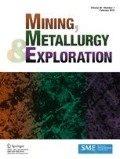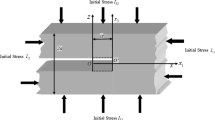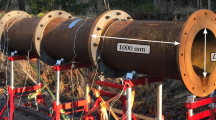Abstract
Rock breakage using blasting is one of the important operations of the mining industry. The delay timing decides the initiation sequence of holes in the blasts and is a crucial factor to improve the overall blast performance. Blast-induced ground vibration is an undesired yet unavoidable outcome of blasting. Peak particle velocity (PPV) is commonly used to measure the magnitude of blast-induced ground vibration. Channelization and better utilization of explosive energy delay are provided between blast holes using initiating systems. The use of different initiation systems even on the same site results in a very significant difference in the values of PPV generated. Due to scattered delay timings of pyrotechnic detonators, the scaled distance predictor equations obtained become unreliable. The error/scatter in delay timing leads to overlapping of holes and hence increases in maximum charge per delay. In this paper, an analytical approach has been discussed to measure the overlapping of holes during blasting with initiation systems having inherent cap scatter. The analytical approach will be calculating the probable overlapping of holes due to scatter in delay timing and will help blasting engineers to understand the variation in maximum charge per delay due to pyrotechnic based initiating systems. In this study, a total number of 102 blasts were conducted using different initiation systems at two different opencast coal mine and 221 corresponding blast vibrations events were recorded.






Similar content being viewed by others
References
Dowding CH, Dowding CH (1996) Construction vibrations, vol 81. Prentice Hall Upper Saddle River, NJ
Mohanty B, Yang R (1997) Blasting vibrations and explosives performance. In: Proceedings of the annual symposium on explosives and blasting research, pp 15–28
Mishra AK (2013) Unlocking possibility of blasting near residential structure using electronic detonators. J Geol Soc India 81(3):429–435
Roy MP, Mishra AK, Agrawal H, Singh PK (2020) Blast vibration dependence on total explosives weight in open-pit blasting. Arab J Geosci 13(13):1–8
Kopp JW, Engineer M, Siskind DE, Geophysicist S (1986) Effects of millisecond-delay intervals on vibration and airblast from surface coal mine blasting. Report of Investigations/1986. Bureau of Mines, Twin Cities Research Center, Twin Cities, Minnesota
USBM and D. E. Siskind (1980) Structure response and damage produced by ground vibration from surface mine blasting. US Department of the Interior, Bureau of Mines New York
Mishra AK, Agrawal H, Raut M (2019) Effect of aluminum content on detonation velocity and density of emulsion explosives. J Mol Model 25(3):70–79
Singh PK, Vogt W, Singh RB, Singh DP (1996) Blasting side effects-investigations in an opencast coal mine in India. Int J Surf Min Reclam 10(4):155–159
Mishra AK, Nigam YK, Singh DR (2017) Controlled blasting in a limestone mine using electronic detonators: a case study. J Geol Soc India 89(1):87–90
Jimeno EL, Jimino CL, Carcedo A (1995) Drilling and blasting of rocks. CRC Press
Singh CP, Agrawal H, Mishra AK (2020) A study on influence of blast-induced ground vibration in dragline bench blasting using signature hole analysis. Arab J Geosci 13(13):1–9
Agrawal H, Mishra AK (2020) An innovative technique of simplified signature hole analysis for prediction of blast-induced ground vibration of multi-hole/production blast: an empirical analysis. Nat Hazards 100(1):111–132
Agrawal H, Mishra AK (2018) Modified scaled distance regression analysis approach for prediction of blast-induced ground vibration in multi-hole blasting. J Rock Mech Geotech Eng
Hustrulid W, Lu W (2002) Some general design concepts regarding the control of blast-induced damage during rock slope excavation. Proc 7th Rock Fragm. by Blasting, Beijing
Silva J, Li L, Gernand JM (2017) Reliability analysis for mine blast performance based on delay type and firing time. Int J Min Sci Technol 28(2):195–204
Agrawal H, Mishra AK (2018) Evaluation of initiating system by measurement of seismic energy dissipation in surface blasting. Arab J Geosci 11(13):345
Garai D, Agrawal H, Mishra AK, Kumar S (2018) Influence of initiation system on blast-induced ground vibration using random forest algorithm, artificial neural network , and scaled distance analysis. Math Model Eng Probl 5(4):418–426
Singh CP, Agrawal H, Mishra AK, Singh PK (2019) Reducing environmental hazards of blasting using electronic detonators in a large opencast coal project - a case study. J Mines Met Fuels 67(7):345–350
Agrawal H, Mishra AK (2017) Evolution of digital detonators as an intelligent tool for control blasting in Indian mines. Annales De Chimie-Science Des Materiaux 41(3–4):157–171
Roy PP, Singh TN (1999) Effect of delay scattering on blasting performance. In: PROCEEDINGS OF THE ANNUAL CONFERENCE ON EXPLOSIVES AND BLASTING TECHNIQUE, vol 1, pp 1–18
Birch WJ, Hosein S (2004) The application of electronic detonators in controlling blast vibrations–a trial study. In: Proceedings of the Thirteenth Extractive Industry Geology Conference, The University of Leeds
Duvall WI, Fogelson DE (1962) Review of criteria for estimating damage to residences from blasting vibrations. US Department of the Interior, Bureau of Mines
Siskind DE, Stagg MS, Kopp JW, Dowding CH (1981) Structure response and damage produced by ground vibration from surface mine blasting. Bur Mines Rep Investig 8507:86
Giraudi A, Cardu M, Oreste P (2013) A review of the benefit of electronic detonators. Min Mining, Esc Minas Ouro Preto 66(3):375–382
McFerren W, Moodley P, Solutions D, (2004) Electronic detonator success: an african story. In: PROCEEDINGS OF THE ANNUAL CONFERENCE ON EXPLOSIVES AND BLASTING TECHNIQUE, vol 2, pp 97–108
Wheeler R, Industrial W (2006) Destructive wave interference in underground blasting utilizing precise timing. 1:1–11
Bartley DA, Trousselle R (1998) Daveytronic, digital detonator testing in a vibration sensitive environment. In: Proc. 24th Ann. Conf. On Explosives and Blasting Technique, New Orleans, Louisiana, USA, pp 247–261
Cardu M, Giraudi A, Oreste P (2013) A review of the benefits of electronic detonators. Rem Rev Esc Minas 66(3):375–382
D. A. Bartley, D. B. A. Consulting, R. Trousselle, and D. Bickford, “Daveytronic , digital detonator testing in a vibration sensitive environment,” pp. 247–262, 2000
Anderson D, Brinckerhoff P (2008) Signature hole blast vibration control-twenty years hence and beyond. In: Proceedings of the Annual Conference on Explosives and Blasting Technique, vol 34, no 2, p 27
Roy MP, Singh PK, Singh G, Monjezi M (2007) Influence of initiation mode of explosives in opencast blasting on ground vibration. Min Technol 116(1):1–6
Chi EA, Zhao MS, Kang Q (2015) Study on blasting vibration reduction technology by digital detonator. In: 5th International Conference on Advanced Design and Manufacturing Engineering. https://doi.org/10.2991/icadme-15.2015.245
Agrawal H, Mishra AK (2018) Probabilistic analysis on scattering effect of initiation systems and concept of modified charge per delay for prediction of blast induced ground vibrations. Measurement 130:306–317
Kumar R, Choudhury D, Bhargava K (2016) Determination of blast-induced ground vibration equations for rocks using mechanical and geological properties. J Rock Mech Geotech Eng 8(3):341–349
Acknowledgments
The authors express their thankfulness to the mine management of “Amalgamate Joyrampur Colliery Lodna Area of Bharat Coking Coal Limited (BCCL)” and “Gondudih Colliery, BCCL” for allowing us to conduct the study in the mines. The study was conducted with the appropriate permission of the competent authority in presence of blasting officers of the mines.
Author information
Authors and Affiliations
Corresponding author
Ethics declarations
Conflict of Interest
The authors declare that they have no conflict of interest.
Additional information
Publisher’s Note
Springer Nature remains neutral with regard to jurisdictional claims in published maps and institutional affiliations.
Rights and permissions
About this article
Cite this article
Agrawal, H., Mishra, A.K. An Analytical Approach to Measure the Probable Overlapping of Holes Due to Scattering in Initiation System and Its Effect on Blast-Induced Ground Vibration in Surface Mines. Mining, Metallurgy & Exploration 38, 485–495 (2021). https://doi.org/10.1007/s42461-020-00350-2
Received:
Accepted:
Published:
Issue Date:
DOI: https://doi.org/10.1007/s42461-020-00350-2




